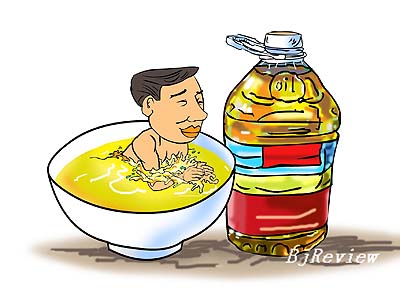|

For someone who was practically weaned on a diet of Chinese food through most of my teenage years, I didn't exactly take to the cuisine like fish to water when I first arrived in China. In fact it was a whole year before I ventured into a Chinese restaurant in Beijing and sampled, rather cautiously, a bowl of rice and a mushroom dish. The result was something of a culture shock to the digestive system: The difference between Indian-style Chinese (Chindian cuisine, if you will) and true Chinese is as vast as the cultural chasm between the two countries. The dissimilarities therein can be observed in the general levels of spiciness, tanginess and experimentation involved.
An Indian friend of mine, who lives in Dubai, visited Beijing for the first time recently. After her first real Chinese meal, she compared Chindian cuisine (which, surprise surprise, is hugely prevalent in Dubai as well) to the crossbreeding of dogs, creating designer hybrids such as a puggle (a mix of pug and beagle) or chug (chihuahua + pug). While the comparison may be odious to some (and involves a fellow writer's creative leap), her point is well taken and is worth an honorary mention, at the very least.
Chindian is tailored to suit the refined and not-so-refined Indian palate. Bombay, in particular, boasts a plethora of Chinese restaurants with rather unimaginative names. China Garden. China Gate. The Great Wall. Chopsticks. Stomach. Each and every one of them purporting to be "authentic"--easily the most overused word in the Chindian bible. The founder of China Garden, Nelson Wang, has even been accorded the status of rock 'n' roll legend; since his restaurant opened in 1984, featuring lusciously outlandish delicacies such as crispy Peking chicken, crispy vegetable pancake, Shantung prawns, gin chicken, and hakka fish, it has attracted the rich and the trendy-movie stars, models, socialites--eager to soak up Chinese ambience (another richly abused word) without leaving town.
At the other end of the spectrum lie the numerous roadside stalls and restaurants, littering the length and breadth of Bombay's inner streets, and catering not to the hip and posh but to those with an appetite for a quick fix. An ex-roommate of mine in a bustling Bombay suburb orders takeout regularly from Legacy of Ming, a nondescript hole in the wall that parades as the poor man's China Garden. When I asked him what his favorite dish was, he said, unhesitatingly, "Momos."
While the Ming Dynasty (1368-1644) probably did not plan for this, it's surely a giant creative leap for the founder, Hongwu, the third of only three peasants ever to become an emperor in China. His rags-to-riches story continues in the dingy nooks of Bombay.
I have yet to make a trip to Calcutta's famous Chinatown, which, by several accounts, rustles up the best Chinese food in India. A Bengali buddy says there's now a newer Chinatown that shifted out of the old one and settled down near the tanneries at the outskirts of the city. "Yeah, it's at least more authentic than the rest of the country, since the cooks are Chinese," he declares, almost proudly.
My favorites as I was growing up were ginger chicken and garlic prawns (or was it the other way around?), not to mention American chopsuey and Chinese chowmein. To me, these comprised the very gist of Chinese cuisine--until I treated my tastebuds recently to gongbao jiding (spicy chicken with peanuts), yuxiang rousi (a sour-spicy pork dish) and kaoya (roasted Beijing duck). I felt the epicure in me experience something of a religious conversion.
There's an adage (probably apocryphal) that dwells on how north Indians put more oil in their food than south Indians pour into their hair. While this may be pandering to stereotypes, there's little doubt that north Indian food is oil-rich, not to mention spicy and succulent (although Tamil Nadu's Chettinad cuisine is probably up there as well in terms of pungency). Imagine my surprise, then, when I encountered the Real Taste of China in a shuizhuyu, a cataclysmic oil spill (from a Russian tanker, most likely) that would have Greenpeace up in arms if they knew. The Chinese not only like their grease, but would give swimming lessons in the same, if they could. Who knew? Not us, nourished on Chindian, for sure.
Today, Ming's ever-evolving legacy takes us into hitherto uncharted culinary realms. In the Indian subcontinent, strange alien repasts have been invented of late, combining aspects of India and China in ways that reek of genetic engineering. Chinese dosa. Chinese bhel ("crushed, crispy won ton pastry bound with a delicious tomato-based sweet and sour sauce, moulded and turned out on a platter"). Punjabi Chinese.
Which leaves just one profound, life-altering query to be answered: What would Paris Hilton (who was in Beijing recently) and her designer poodle make of Chindian cuisine? Watch this space.
The author is an Indian living in Beijing |
